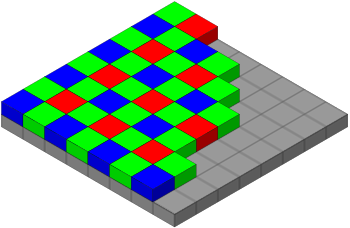
Back Filtre mosaic de Bayer Catalan Bayerova maska Czech Bayer-Sensor German Mosaico de Bayer Spanish فیلتر بایر Persian Matrice de Bayer French Schema Bayer Italian ベイヤーフィルター Japanese 베이어 필터 Korean Bayerfilter Dutch


A Bayer filter mosaic is a color filter array (CFA) for arranging RGB color filters on a square grid of photosensors. Its particular arrangement of color filters is used in most single-chip digital image sensors used in digital cameras, and camcorders to create a color image. The filter pattern is half green, one quarter red and one quarter blue, hence is also called BGGR, RGBG,[1][2] GRBG,[3] or RGGB.[4]
It is named after its inventor, Bryce Bayer of Eastman Kodak. Bayer is also known for his recursively defined matrix used in ordered dithering.
Alternatives to the Bayer filter include both various modifications of colors and arrangement and completely different technologies, such as color co-site sampling, the Foveon X3 sensor, the dichroic mirrors or a transparent diffractive-filter array.[5]
- ^ Jeff Mather (2008). "Adding L* to RGBG". Archived from the original on 2011-07-13. Retrieved 2011-02-18.
- ^ dpreview.com (2000). "Sony announce 3 new digital cameras". Archived from the original on 2011-07-21.
- ^ Margaret Brown (2004). Advanced Digital Photography. Media Publishing. ISBN 0-9581888-5-8.
- ^ Thomas Maschke (2004). Digitale Kameratechnik: Technik digitaler Kameras in Theorie und Praxis. Springer. ISBN 3-540-40243-8. Archived from the original on 2019-01-09. Retrieved 2016-09-23.
- ^ Wang, Peng; Menon, Rajesh (29 October 2015). "Ultra-high-sensitivity color imaging via a transparent diffractive-filter array and computational optics". Optica. 2 (11): 933. Bibcode:2015Optic...2..933W. doi:10.1364/optica.2.000933.